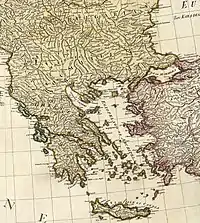Койне (мовознавство)
У мовознавстві койне (від грец. κοινὴ διάλεκτος — спільна мова) — це стандартизована або загальноприйнята мова чи діалект, що виникла в результаті контакту, змішування та часто спрощення двох або більше взаємозрозумілих різновидів однієї мови.[1]

Оскільки мовці вже розуміли один одного до появи койне, процес койнезації не такий різкий, як піджинізація та креолізація . На відміну від піджинізації та креолізації, у койнезації немає «цілі», та мовцям не потрібно відмовлятися від своїх власних мовних різновидів.
Нормальний вплив між сусідніми діалектами не розглядається як койнезація. Різновид койне з'являється як новий розмовний різновид на додаток до початкових діалектів. Це не змінює жодного існуючого діалекту, що відрізняє койнезацію від нормальної еволюції діалектів.[2]
Діалекти койне
- Австралійська англійська, діалект, який спочатку виник як суміш англійської кокні та ірландської англійської 18-го століття, а згодом певним чином вплинув на англійську літературну вимову в 19-му столітті.[3]
- Центральноазіатська корейська (корьо мар), заснована на юкчинському діалекті та багатьох інших різновидах північно-східної корейської .[4]
- Поетичний койне на основі староарабської і класичної арабської.
Мови койне
- Фіджійська гінді
- Карибська гіндустані
- Дано-норвезька, основа найбільш широко використовуваного письмового стандарту Норвегії, букмол .
- Грецька койне, мова, яка дала назву загальному явищу.
- Сучасний іврит, унікальний тим, що є тимчасовим койне різних етапів івриту.
- Паленбангська мова, на якій розмовляють на Південній Суматрі.
Див. також
- Діалектний континуум
- Лінгва франка
- Змішані мови
- Взаємна зрозумілість
- Стандартизована мова
Примітки
- Siegel, Jeff (2001). Koiné formation and creole genesis. Creolization and Contact. John Benjamins Publishing Company. с. 175. ISBN 978-90-272-9771-6.
- For example: Campbell, John Howland; Schopf, J. William, ред. (1994). Creative Evolution. Life Science Series. Jones & Bartlett Learning. с. 81. ISBN 9780867209617. Процитовано 20 квітня 2014. «[...] the children of pidgin-speaking parents face a big problem, because pidgins are so rudimentary and inexpressive, poorly capable of expressing the nuances of a full range of human emotions and life situations. The first generation of such children spontaneously develops a pidgin into a more complex language termed a creole. [...] [T]he evolution of a pidgin into a creole is unconscious and spontaneous.»
- Kerswill, P. (2002). Koineization and accommodation. In J. K. Chambers, P. Trudgill & N. Schilling-Estes (Eds.), The handbook of language variation and change (pp. 669—702). Oxford: Blackwell.
- Kwak, Chung-gu (2007). Data and Ressarches for Korean dialect in Central Asia. Journal of Humanities (кор.) 85: 231–272 — через Institute of Humanities.
Джерела
- Britain, D; Trudgill, Peter (1999). Migration, new-dialect formation and sociolinguistic refunctionalisation: Reallocation as an outcome of dialect contact.. Transactions of the Philological Society 97 (2): 245–256. doi:10.1111/1467-968x.00050.
- Kerswill, P. Koineization and Accommodation. У Trudgill, Peter; Schilling-Estes, N. The handbook of language variation and change. Oxford: Blackwell Publishing. с. 669–702.
- McWhorter, John H. (1998). Identifying the creole prototype: Vindicating a typological class. Language 74 (4): 788–818. JSTOR 417003. doi:10.2307/417003.
- Mesthrie, R. (2001). Koinés. У Mesthrie, R. Concise encyclopedia of sociolinguistics. Amsterdam: Elsevier. с. 485–489.
- Siegel, Jeff (1985). Koines and koineization.. Language in Society 14 (3): 357–378. doi:10.1017/s0047404500011313.
- Trudgill, Peter (1986). Dialects in contact. Oxford: Blackwell Publishing.
- Weinreich, Uriel (1953). Languages in Contact: Findings and Problems. ISBN 9783110802177.
